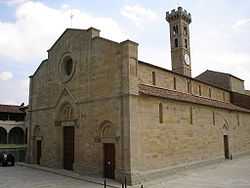Fiesole Cathedral
| Fiesole Cathedral Catedrale di San Romolo di Fiesole (Italian) | |
|---|---|

Fiesole Cathedral | |
| Basic information | |
| Location | Fiesole, Italy |
| Geographic coordinates | 43°48′26″N 11°17′33″E / 43.80722°N 11.29250°ECoordinates: 43°48′26″N 11°17′33″E / 43.80722°N 11.29250°E |
| Affiliation | Roman Catholic |
| Year consecrated | 1028 |
| Ecclesiastical or organizational status | Cathedral |
| Leadership | Mons. Mario Meini |
| Website | www.diocesifiesole.it |
| Architectural description | |
| Architectural type | Church |
| Architectural style | Romanesque |
| Completed | 1028 |
| Specifications | |
| Length | 55 metres (180 ft) |
| Width | 27 metres (89 ft) |
| Width (nave) | 11 metres (36 ft) |
Fiesole Cathedral (Italian: Cattedrale di San Romolo, Duomo di Fiesole) is a Roman Catholic cathedral in Fiesole, Tuscany, central Italy. It is the seat of the Bishop of Fiesole and is dedicated to Saint Romulus.
History
The first cathedral of Fiesole was situated lower down the hill than the present one, and had been built, according to the tradition, over the site of the martyrdom of Saint Romulus of Fiesole. In 1028[1] the present cathedral was founded by Bishop Jacopo the Bavarian to replace it, as he wished it to be inside the city walls. The old cathedral was converted into a Benedictine abbey and became known as the "Badia di Fiesole". It was rebuilt in 1466 by a disciple of Filippo Brunelleschi.[2] Its façade, dating from the 11th century, is still preserved. It contains notable early works by Mino da Fiesole. The abbey was closed in 1778.[1]
Description
The exterior is Romanesque. The cathedral is built on the basilica floorplan with a nave and two aisles separated by stone columns which have capitals decorated with figures and animals. It has a raised presbytery over the crypt and a trussed ceiling. The picturesque battlemented campanile was built in 1213. The church was restored in 1256.[2]

The interior has little decoration, apart from the marble altar (1273) and two frescoes, depicting Saint Benedict (c. 1420) and Saint Sebastian by Pietro Perugino (late 15th century). In the presbytery is a polyptych of the Three stories of Saint Nicholas, by Bicci di Lorenzo, commissioned in 1450. In the Salutati Chapel is the funerary monument of bishop Leonardo Salutati, executed by Mino da Fiesole.[3] In the Canon's Chapel is a marble altar by Andrea Ferrucci (1492-1494).
In the counter-façade is a huge statue of Saint Romulus by Giovanni della Robbia (1521). The crypt's small columns have 11th century capitals, perhaps taken from the original construction. The decoration includes late Gothic medallions on the vault, while on the left wall is a cycle of the Stories of St. Romulus by the school of Domenico Ghirlandaio. The bishops' funerary chapel has a 13th-century icon attributed to one "Master of Bigallo", portraying the Madonna and Child (1215-1220).
Notes
- ↑ 1.0 1.1 Hemans, Charles Isidore (1869). A history of mediaeval Christianity and Sacred art in Italy 1. Williams and Norgate. p. 174. Retrieved 28 November 2010.
- ↑ 2.0 2.1
 Chisholm, Hugh, ed. (1911). "Fiesole". Encyclopædia Britannica (11th ed.). Cambridge University Press
Chisholm, Hugh, ed. (1911). "Fiesole". Encyclopædia Britannica (11th ed.). Cambridge University Press - ↑ Toscana: Duomo di Fiesole (Italian)
References
 This article incorporates text from a publication now in the public domain: Chisholm, Hugh, ed. (1911). "Fiesole". Encyclopædia Britannica 10 (11th ed.). Cambridge University Press. p. 329
This article incorporates text from a publication now in the public domain: Chisholm, Hugh, ed. (1911). "Fiesole". Encyclopædia Britannica 10 (11th ed.). Cambridge University Press. p. 329
| Wikimedia Commons has media related to Duomo (Fiesole). |